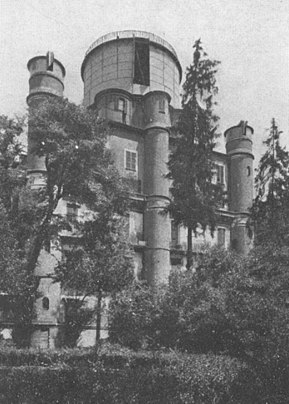Brera Astronomical Observatory
 (ca. 1886-1890) | |
| Alternative names | osservatorio astronomico di Brera |
|---|---|
| Observatory code | 027 |
| Location | Brera district of Milan, Italy |
| Coordinates | 45°28′19″N 9°11′16″E / 45.47199°N 9.1877°E |
| Website | http://www.brera.inaf.it,%20http://www.brera.unimi.it |
| Telescopes | |
| | |
The Brera Observatory (Italian: Osservatorio Astronomico di Brera) is an astronomical observatory in the Brera district of Milan, Italy. It was built in the historic Palazzo Brera in 1764 by the Jesuit astronomer Roger Boscovich.[1] Following the suppression of the Jesuits by Clement XIV on 21 July 1773, the palace and the observatory passed to the then rulers of northern Italy, the Austrian Habsburg dynasty.[2]
From 1 December 1786, the Austrian Empire adopted “transalpine time”. The astronomers were engaged by Count Giuseppe Di Wilczek, the plenipotentiary governor of Lombardy, to build a meridian line inside Milan Cathedral.[3] It was constructed by Giovanni Angelo Cesaris and Francesco Reggio, with Roger Joseph Boscovich acting as a consultant.
Following the incorporation of Milan into the Kingdom of Italy in 1861, the observatory has been run by the Italian government.

In 1862, the newly installed Italian government improved the observatory's facilities by commissioning a 218mm Merz Equatorial Refracting Telescope to the German constructor Georg Merz.[4][5] In 1946 the observatory became part of the scientific institutions of the new born Italian Republic and since 2001 it has become part of the National Institute of Astrophysics (INAF).
Astronomer Margherita Hack worked at the Observatory from 1954 to 1964, until she became Professor of the Institute of Physics at the Trieste University.
Today the Observatory's staff consists of approximatively one hundred people. The research area covers a large range of fields from planets to stars, black holes, galaxies, gamma-ray bursts and cosmology. The Observatory is also active in the technological research applied to the astronomical instrumentation and it is one of the world leaders in the development of X-ray astronomy optics and light instrumentation for space missions.[6]
The Museum
[edit]The Observatory Museum's collection features astronomical instruments used by the Brera astronomers over the years, from the early days of the Observatory to the 1970s. The collection, started by Giovanni Schiaparelli and enriched by subsequent directors, is displayed in the entrance hall of the Observatory. The present layout of the gallery is the result of an effort aimed at the preservation and promotion of the items on display, which have been restored and catalogued as part of a project started by the Institute for General and Applied Physics of the University of Milan. The Observatory's nucleus of astronomical instruments has been enriched with miscellaneous scientific instruments that are part of the historical collection of the University of Milan. These include telescopes, microscopes, pneumatic and electrostatic devices, instruments for cartographic surveys of the 18th-19th century.
The dome with the 8-inch refracting telescope which Schiaparelli had installed in 1875 is also part of the Museum. Schiaparelli used this telescope for his astronomical researches of binary stellar systems, comets, asteroids and planets of the Solar System, and particularly Mars. In 1999 the telescope and the dome were fully restored to be operational, and are open to the public.
Notable people
[edit]- Laura Maraschi, Italian astronomer
See also
[edit]References
[edit]- ^ Mario Carpino (2010). Breve storia dell'Osservatorio Astronomico di Brera attraverso i suoi strumenti (in Italian). Osservatorio Astronomico di Brera. Accessed July 2015.
- ^ Giuseppe Schio (1930). Brera (in Italian). Enciclopedia Italiana. Roma: Istituto dell’Enciclopedia Italiana. Accessed July 2015.
- ^ Heilbron, John Lewis (1990). The Sun in the Church. Cathedrals as Solar Observatories. Harvard University Press. p. 268. ISBN 0674005368.
- ^ http://www.brera.unimi.it/index.php?option=com_content&view=article&id=75&Itemid=137&lang=en Archived 2014-12-22 at the Wayback Machine Brera Astronomical Observatory, refracting telescope that was ordered to the German constructor Georg Merz (1793-1867).
- ^ Bernagozzi, Andrea; Testa, Antonella; Tucci, Pasquale (2004). "Observing Mars with Schiaparelli's telescope". Third European Workshop on Exo-Astrobiology. 545: 157. Bibcode:2004ESASP.545..157B. In 1862, The Government of Italy funded the purchase of a 218mm Merz Equatorial Refracting Telescope for the Brera Astronomical Observatory
- ^ "INAF - OA-Brera".

